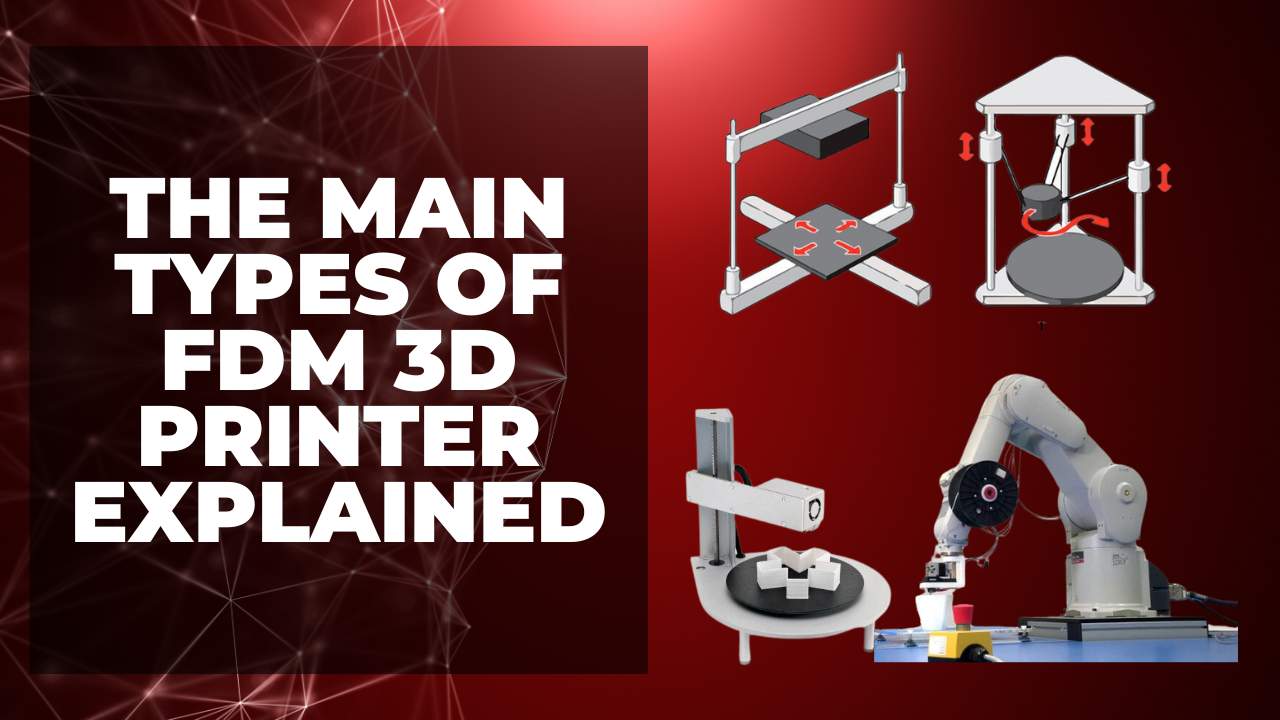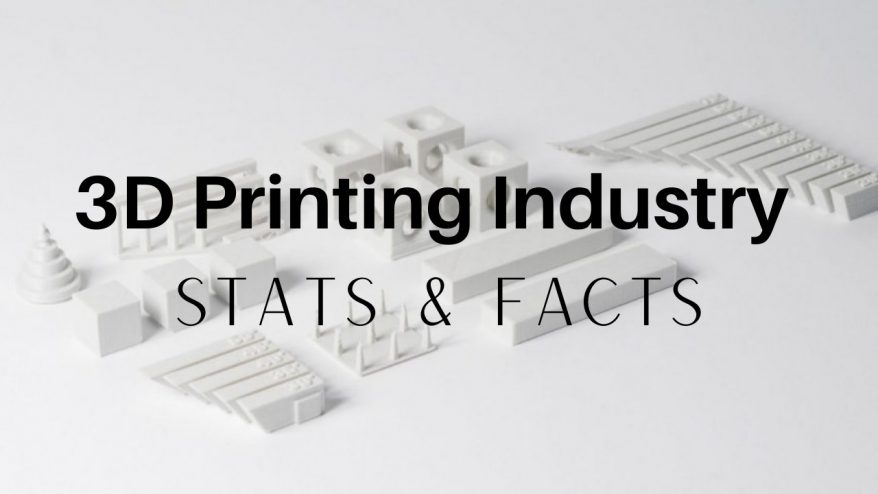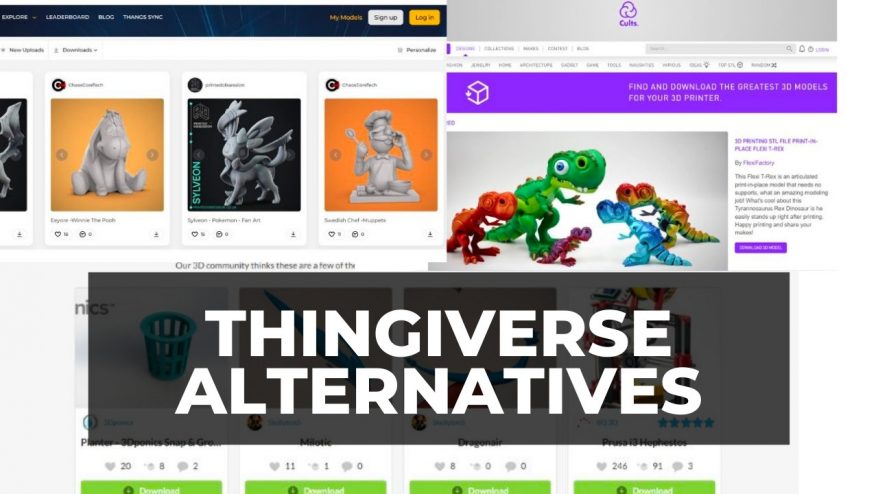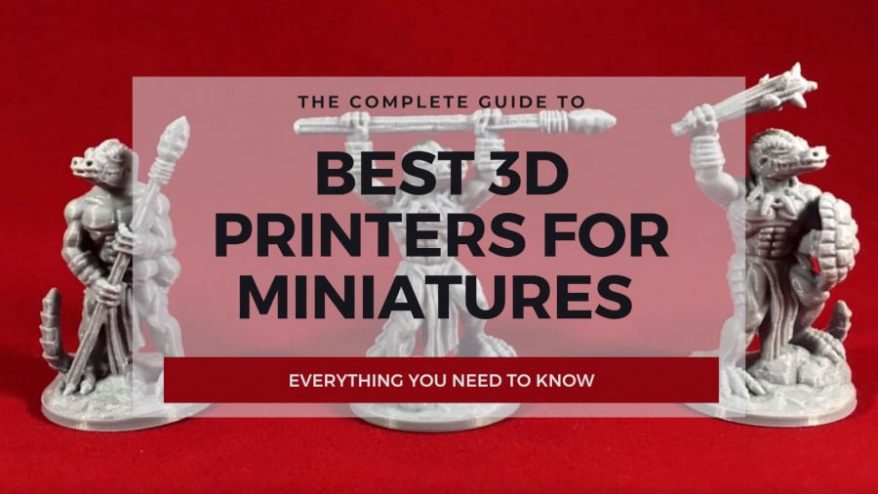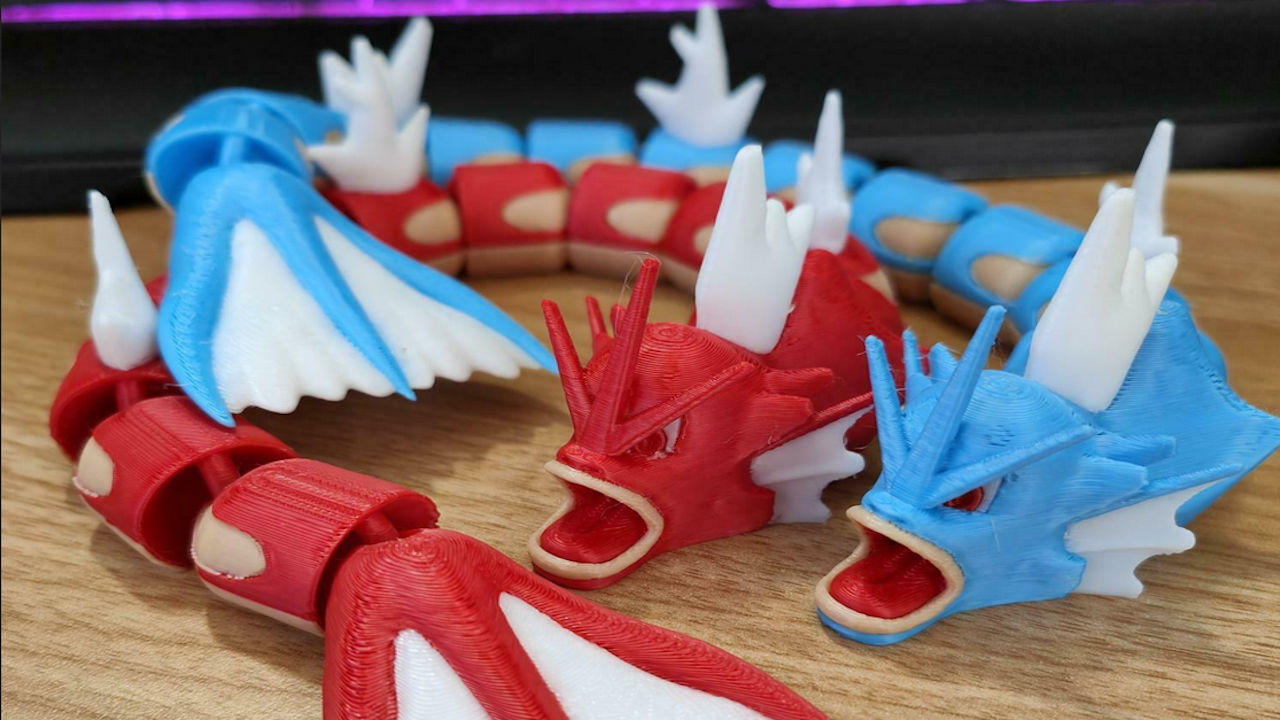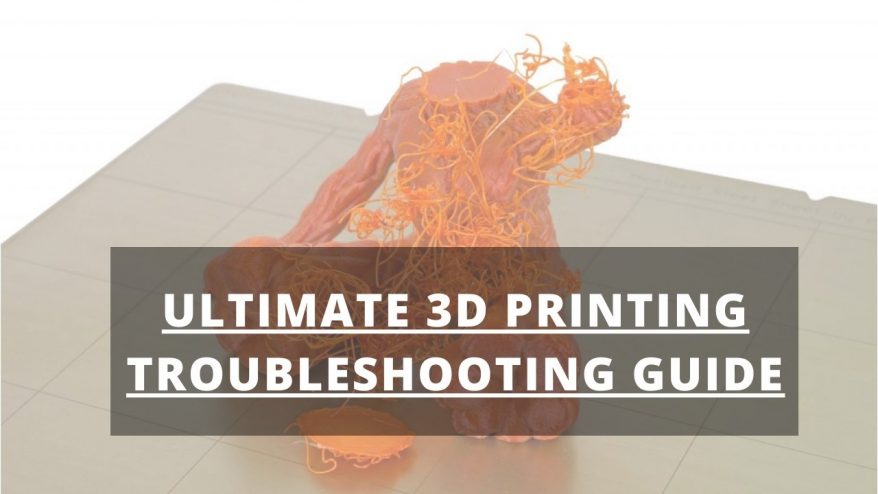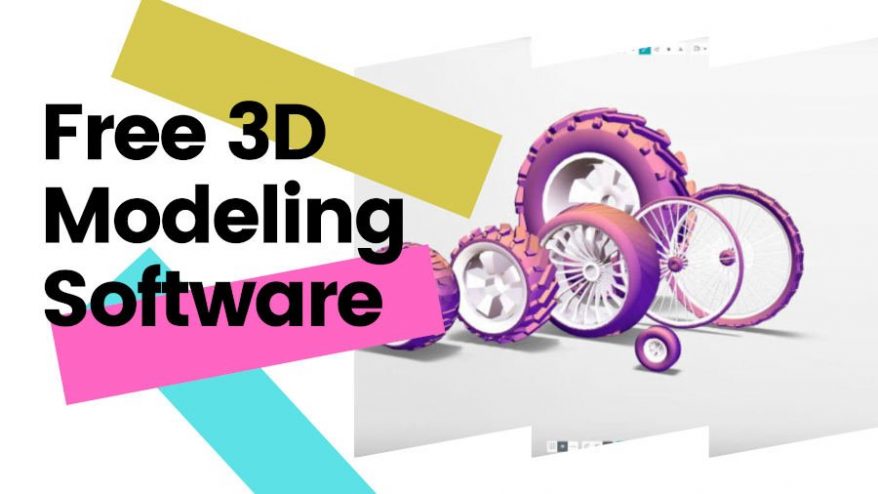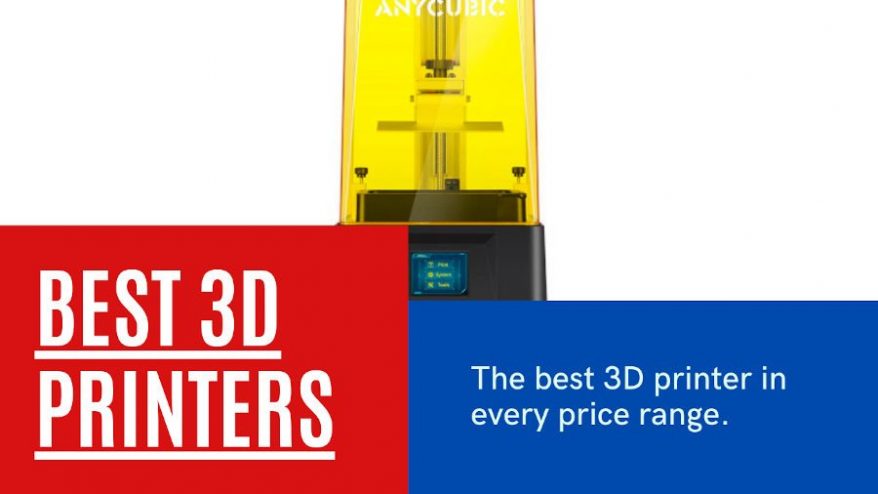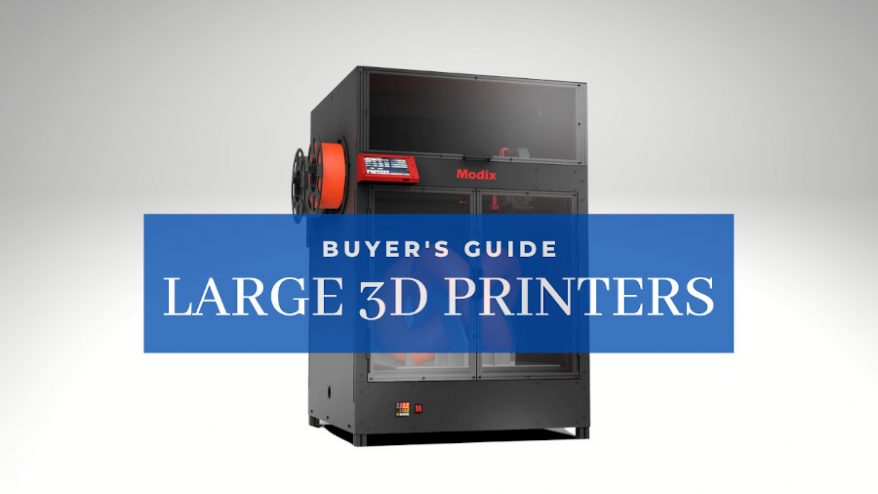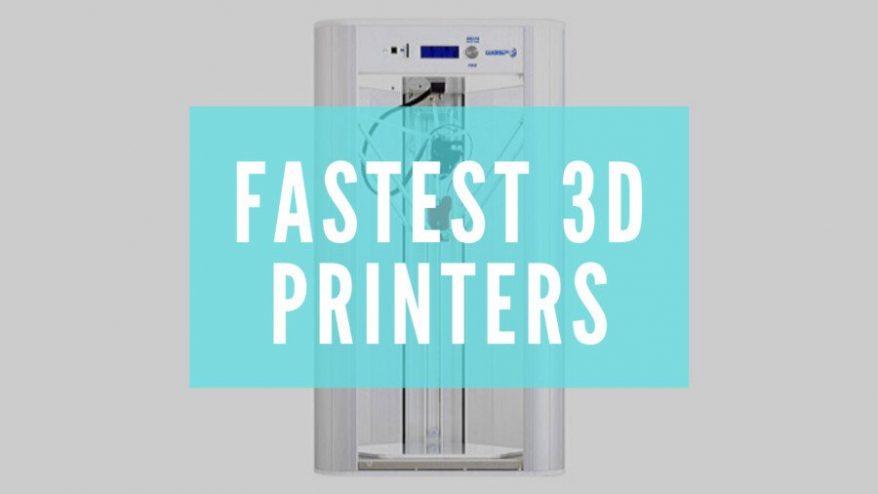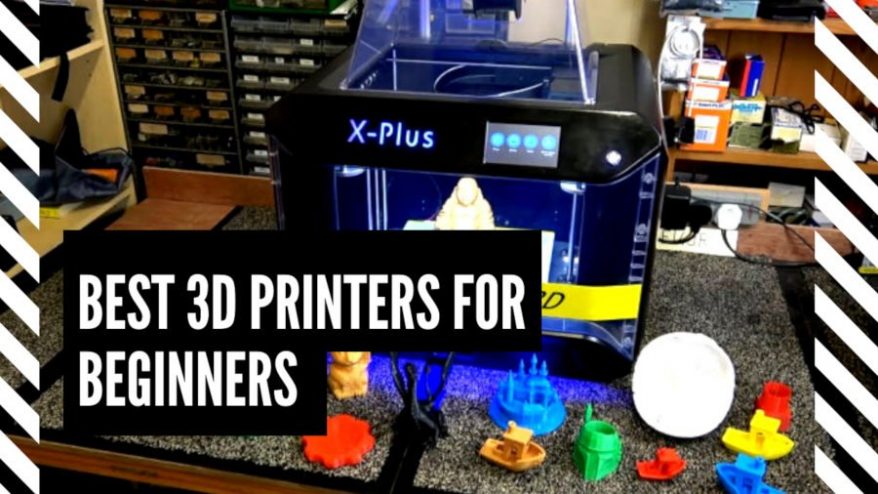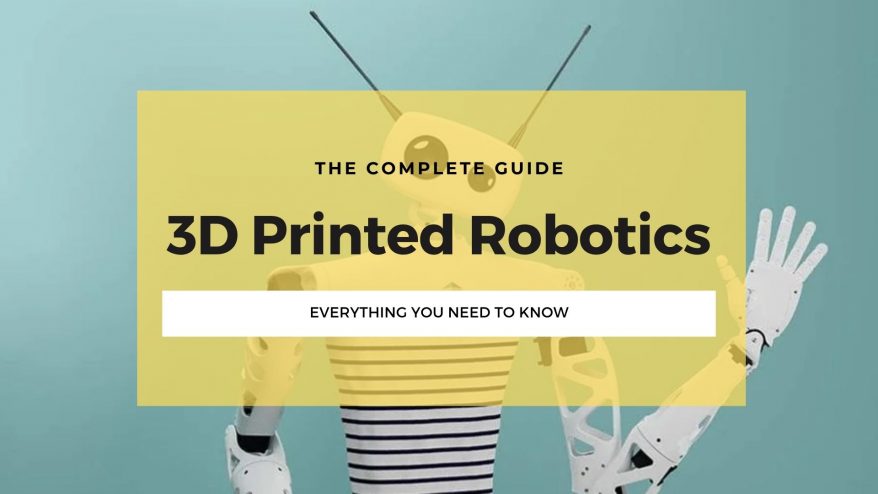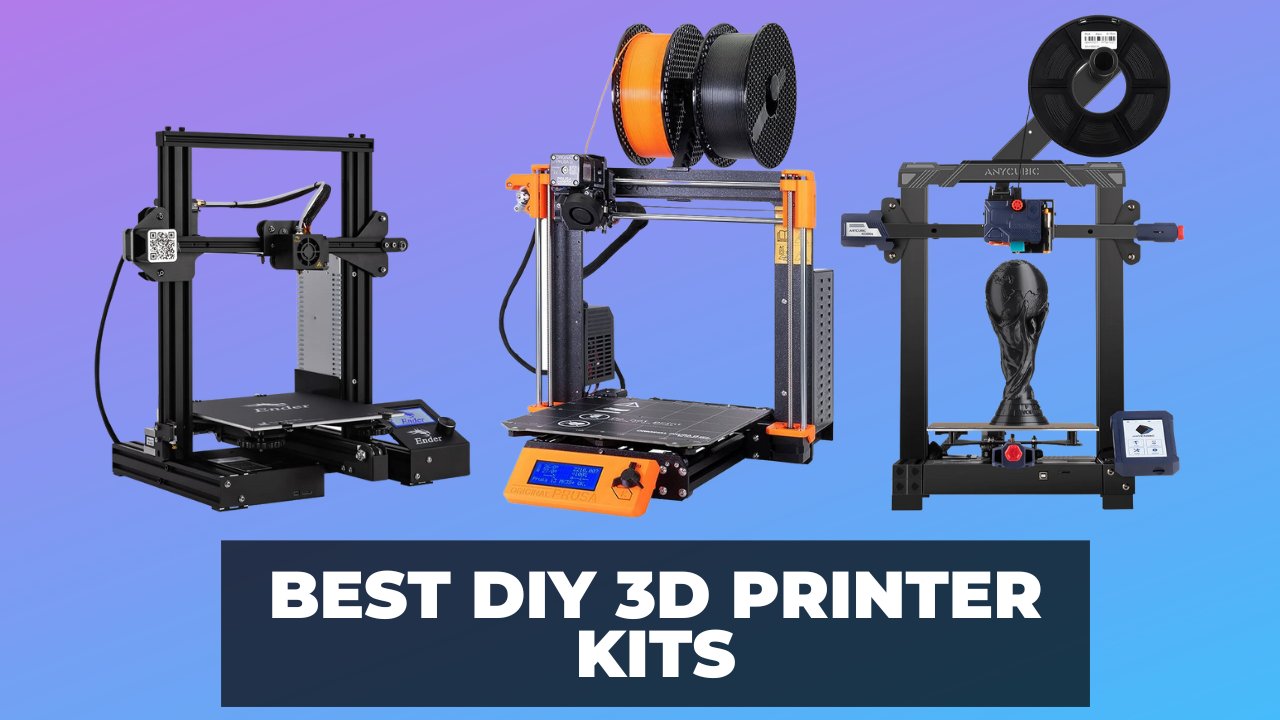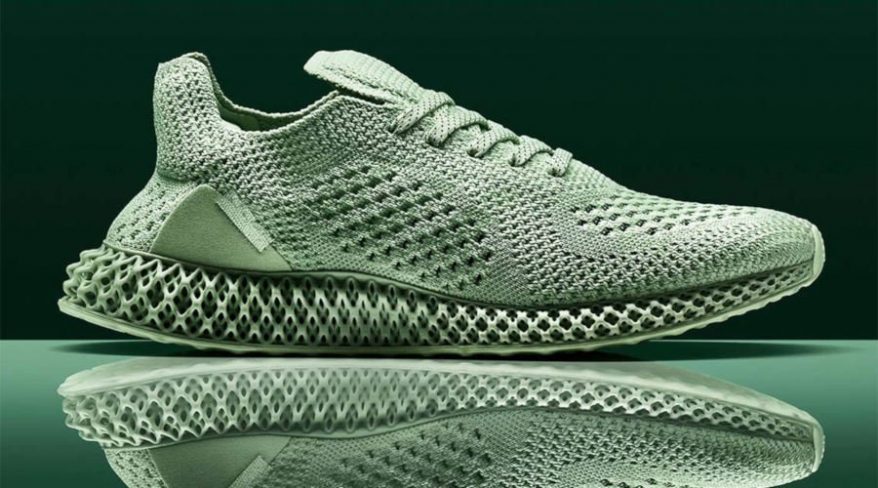3D printing is an amazing and accessible technology – but some of the technical terms and acronyms can be a little confusing for beginners.
The aim of this printing glossary is to lay out the definitions for all of the common vocabulary you’re likely to come across in 3D printing.
So let’s cut through the confusion and clear up the most common 3d printing terms.
(P.S- if you find that there’s a particular 3d printing terminology that wasn’t included, let us know in the comments and we’ll be glad to add it in.)
- Key 3D Printing Terminology
- 3D Modeling
- 3D Printing
- 3D Printer
- 3D Printing Pen
- 45° Rule
- ABS
- Acetone
- Additive Manufacturing
- Adhesion
- ASA
- Atomic Method
- Bed
- Bed Leveling
- Belt
- Binder Jetting
- Blue Painter’s Tape
- Bottom/Top Thickness
- Bowden Extruder
- Bowden Tube
- Bridge
- Brim
- Build Surface
- Buildtak
- Build Volume
- CAD
- Cartesian Coordinates
- Chamfer
- CLIP
- CNC
- Cold End
- Cold Method
- Copolymer
- Cracking
- Curing
- DED
- Desiccant
- Direct Drive Extruder
- DLP
- DMLS
- Dual Extrusion
- EBM
- Enclosure
- End Stops
- Extrude
- Extruder
- Extruder Motor
- Fan
- FDM
- Feeder
- FFF
- FFM
- Filament
- Filament Drive Gear
- Fill Density
- Frame
- GCode
- Glue Stick
- Hairspray
- Hardening
- Heat Creep
- Heat Sink Fan
- Heated Build Chamber
- Heated Print Bed
- HIPS
- Hobbed Gear
- Hot End
- Hydrolysis
- Hygroscopic
- Infill
- Kapton Tape
- Knurled Wheel
- Layer
- Layer Cooling Fan
- Layer Height
- Limonene
- Lost Wax Casting
- MJ
- MEM
- Motherboard
- Multi Jet Fusion
- Nylon
- OBJ
- Overhang
- Painter’s Tape
- PC
- PEI
- Perimeter
- PETG
- Photopolymer
- PID Tuning
- Pillowing
- PLA
- PMM
- Polycarbonate
- PolyJet
- Polymer
- Power Supply
- PP – Polypropylene
- Print Bed
- Print Head
- Print Nozzle
- Print Resolution
- Print Speed
- Printing Temperature
- Printing Volume
- PVA
- Raft
- RepRap
- Retraction
- Shell
- Shell Thickness
- SLA
- Slice
- Slicer
- SLS
- Soluble Materials
- Solvent Method
- Splitting
- STL
- Stringing
- Support Materials
- Support Structures
- Stepper Motor
- Subtractive Manufacturing
- Thermistor
- Thermoplastic
- TPU
- ULTEM
- Under Extrusion
- User Interface
- Warping
- Water Method
- X-Axis
- Y-Axis
- Z-Axis
Key 3D Printing Terminology
3D Modeling
3D modeling is the process of developing a digital depiction of a three dimensional object using computer aided design software. Without a 3D model there can be no 3D print. See also CAD.
3D Printing
3D printing is a process where a three dimensional object is created from a digital model, usually by depositing multiple layers of material. See also additive manufacturing.
3D Printer
A machine that produces a three dimensional object one layer at a time. There are several different types of 3d printers each using a different 3d printing method. See also FDM, SLA and SLS.
3D Printing Pen
A handheld tool that uses FDM technology and thermoplastic filament to allow users to create three dimensional objects by laying down layers of extruded print material.

45° Rule
A general rule used in 3d modeling that advises against designing objects that contain angles greater than 45° unless a support material is used. See also Bridge, Chamfer, Overhang and Support Materials.
ABS
Short for Acrylonitrile Butadiene Styrene. ABS is a thermoplastic printing filament used in FDM-type 3d printers. It is a petroleum-based plastic that is not biodegradable. However, it is recyclable. ABS is strong, durable and soluble in acetone. It has a printing temperature between 230C and 250C. When printing with ABS, the use of a heated printing bed (around 90C) is recommended to prevent warping.
Acetone
A chemical solvent used in 3D printing as a vapor bath that is used to finish objects made with ABS. Acetone must be handled carefully in a well-ventilated environment well away from any flame sources.
Additive Manufacturing
The process of creating a three-dimensional object from a 3D model by adding materials, usually one layer at a time. 3D printing is an additive manufacturing technology.
Adhesion
The process whereby extruded thermoplastic filament sticks to the build surface of an FDM-type during the 3D printing process. Adhesion is necessary in order to successfully print a three-dimensional object using thermoplastic filament. Lack of adhesion can cause a printed object to warp as it cools. See also warping.
ASA
Short for Acrylonitrile Styrene Acrylate. ASA is a cousin of ABS that offers the strength of ABS along with UV and overall weather resistance. This makes ASA a great choice for any object that has an outdoor application or will be exposed to weather. ASA has a printing temperature of 235C to 255C and offers a finish similar to PLA.
Atomic Method
A method of unclogging the clogged print nozzle of a FDM-type 3D printer. More information on the atomic method can be seen here.
Bed
Another name for the build plate of an FDM-type 3d printer. It is usually made of aluminum or glass. See also Print Bed.
Bed Leveling
The process of adjusting the bed of a FDM-type printer to ensure that it is level and at a right angle to the print head. Bed leveling is critical to obtaining a successfully printed object.
Belt
Used in a FDM-type printer to take the rotational energy of the stepper motors and use it to move the print head along the x and y axes. Belts are toothed and are usually reinforced to inhibit stretching.
Binder Jetting
A metal 3D printing technology which involves depositing a binding agent onto a powder bed to form a part.
Blue Painter’s Tape
Used in FDM printing on the bed of a printer to improve adhesion.
Bottom/Top Thickness
A slicer program setting that is used to determine how much material will be laid down before the infill printing starts and how much material will be laid down after the infill printing is finished. See also Slicer.
Bowden Extruder
A method of conveying thermoplastic filament used by some FDM-type 3D printers. On a printer with a Bowden extruder, the cold end is separated from the hot end and attached somewhere on the printer frame. See also Cold End and Hot End.
Bowden Tube
A part on some FDM-type 3D printers with a Bowden extruder setup. The Bowden tube is used to guide thermoplastic filament from the feeder assembly in the cold end to the hot end where it is heated and extruded.
Bridge
A 3d modeling term to describe a horizontal overhang placed between two vertical supports.

Brim
A brim is a layer or layers of extruded thermoplastic that is used to stabilize small parts or islands on a printed object. A brim helps these areas to adhere to the print bed. Unlike a raft, a brim is connected only to the perimeter of an island, not to the bottom.
Build Surface
The surface on which a printed object is produced. Often various types of build surfaces will be placed onto or attached to the printer bed to improve adhesion.
Buildtak
Used in FDM printing on the bed of a printer to improve adhesion. More information on the use of Buildtak can be found here.
Build Volume
The maximum size of an object that a 3d printer can produce, measured in length times width times height.
CAD
Short for Computer Assisted Design. CAD is the use of computer software to produce a digital design in either two or three dimensional formats that can then be used to print a physical object.
CAD was originally developed for use in architecture and engineering. However, there are now a number of user-friendly applications on the market that are either free or available at a low cost.
Cartesian Coordinates
A system of coordinates along three axes representing length, width and height and expressed as x, y and z. Cartesian coordinates are used by 3d printers to move through three dimensions while printing an object.
Chamfer
A 3d modeling term that describes a symmetrical, sloping surface at an edge or corner that is used to avoid violating the 45° rule.
CLIP
Continuous Light Interface Production: A 3D printing technology utilized by Carbon 3D to create parts far faster than most other technologies. Uses a similar technology to Stereolithography.
CNC
Computer Numerical Control: A subtractive manufacturing method involving a machine removing parts from a block of material to create the finished part. An alternative to 3D printing and additive manufacturing.
Cold End
A part on an FDM-type 3d printer. The cold end grabs and pulls thermoplastic filament from the spool it is stored on and moves it into the hot end.
A typical cold end consists of either a hobbed gear or knurled wheel that is attached to a feeder motor. As the shaft of the motor spins, it rotates the hobbed gear or knurled wheel which grabs the filament and moves it toward the hot end.
Cold Method
See Atomic Method
Copolymer
A type of plastic used in FDM printing. A copolymer is a material that is made up of several substances, each of which exists in long molecular chains. For example, ABS is a copolymer and consists of strands of acrylonitrile, butadiene, and styrene molecules all bound together.

Cracking
A 3D printing defect. Cracking occurs when one layer of print material bonds inadequately with another layer. When this happens, as the object cools, a split or crack occurs between the two inadequately bonded layers. See also Splitting.
Curing
The process of hardening a 3d printing material to its final form. Commonly used term in SLA printing where light is used to harden liquid photopolymer resin. See also Hardening and SLA.
DED
Direct Energy Deposition: A form of metal 3D printing used by companies such as Sciaky and Optomec to create metal parts.
Desiccant
A hygroscopic substance used as a drying agent. Desiccants are often employed in FDM printing where many printing materials are hygroscopic. See also hydrolysis.
Direct Drive Extruder
A method of conveying thermoplastic filament used by some FDM-type 3d printers. On a printer with a direct drive extruder, the cold end is placed on top of the hot end. See also Cold End and Hot End.
DLP
Short for Digital Light Processing. A form of 3D printing where a light source is used to cure photopolymer resin to produce a printed object.
DMLS
Direct Metal Laser Sintering: One of the most common metal 3D printing technologies, DMLS is similar to Selective Laser Sintering in that material powders are fused layer-by-layer in a process of powder bed fusion, though with SLS plastics are used rather than metals with DMLS.
Dual Extrusion
A FDM-type 3D printer with two extruders. Each extruder can print with a different filament material. Useful for building soluble support structures and producing multicolored objects.
EBM
Electron Beam Melting: A form of metal 3D printing used by companies such as Arcam that is similar to DMLS but instead uses an electron beam rather than a laser.
Enclosure
A part on a 3D printer that protects the user from moving parts and high-temperature objects. Is also used to increase or stabilize the ambient air temperature around the print to stop warping or cracking of the print, caused from cooling too fast.
End Stops
A part of a 3D printer. End stops are switches mounted on each of a printer’s axes. The switch is tripped when a particular axis moves to its end. End stops enable a 3d printer to find its starting point when beginning to print.
Extrude
The process of forcing out a thin layer of melted thermoplastic onto a build surface in order to build up a printed object.
Extruder
See Bowden Extruder and Direct Drive Extruder.
Extruder Motor
A motor in the cold end that uses a hobbed gear or knurled wheel to move thermoplastic filament from a storage spool to the hot end for extrusion.
Fan
See Heat Sink Fan and Layer Cooling Fan.
FDM
Short for Fused Deposition Modeling. A 3D printing process where melted thermoplastic is deposited in successive layers to produce a finished object using a digital model.
Feeder
See Cold End.
FFF
Short for Fused Filament Fabrication. An alternative name for FDM.
FFM
Short for Fused Filament Manufacturing. An alternative name for FDM.
Filament
The printing material used by FDM-type 3d printers. Filament is usually a thermoplastic that is fed by a cold end to the hot end as a solid. In the hot end it is heated to a printing temperature and extruded out through the print nozzle.
Filament comes in different diameters and usually sold in spools. There is a wide variety of filament materials available, as well as a wide variety of quality. In general, a high-quality filament will produce better end results that a less expensive filament that may be of poorer quality
To view our Ultimate Filament Comparison Guide, click here.
Filament Drive Gear
A part on a FDM-type 3d printer. The filament drive gear grabs that printing filament and moves it off of the storage spool and to the hot end of the printer for extrusion.

Fill Density
A slicer program setting that is a measure of how much material will be printed inside the outer shell of the object in question. Infill density is used to conserve filament while printing and speed up printing times. More information on slicer program settings can be found here.See also Slicer.
Frame
A part of a 3d printer. The frame is the chassis or outer case of a 3d printer. The frame is usually made of acrylic plastic, aluminum or stainless steel. A solid frame reduces printer vibration which increases printer accuracy and results in more precise end objects.
GCode
A program language that controls the actions of a 3d printer – things like motion, speed, rotation and depth. Commonly, this code is generated by a slicer program. See also Slicer.
Glue Stick
Used in FDM printing on the bed of a printer to improve adhesion. More information on the use of glue stick can be found here.
Hairspray
Used in FDM printing on the bed of a printer to improve adhesion. Not recommended due to mess and inconsistencies.
Hardening
See Curing.
Heat Creep
Heat creep is a problem that occurs in FDM-type 3d printers when higher temperatures extend back and upwards from the hot end. This causes the “melt area” to extend father back as well, softening and melting the print material well before the nozzle end of the extruder.
The softened thermoplastic increases the amount of pressure needed for extrusion. Eventually, the extruder motor can’t keep up and the nozzle gets clogged.
Heat Sink Fan
A part of an FDM-type 3D printer. A heat sink fan helps to dissipate the heat from the heat sink in the hot end.
Heated Build Chamber
A part of an FDM-type 3D printer. An enclosed compartment around the build plate that eliminates drafts and temperature variations to reduce or prevent material warping.
Heated Print Bed
A part on an FDM-type 3D printer. A heated print bed keeps the build surface warm, promoting greater adhesion and decreasing incidents of warping.
HIPS
Short for high-impact polystyrene. High impact polystyrene is a 3d printing filament that is strong, durable, non-toxic and recyclable. It combines the hardness of polystyrene with the elasticity of rubber to produce a high-impact thermoplastic that is tough and strong without being brittle.
In 3D printing, HIPS makes an excellent soluble support material. HIPS is soluble in Limonene, an easily obtainable solvent that is derived from the skin of lemons.
Hobbed Gear
See Filament Drive Gear.
Hot End
A part on an FDM-type 3d printer. The hot end heats the thermoplastic printing filament to melting temperature and extrudes the melted material onto the build surface.
A typical hot end consists of a heating block which produces the heat necessary to melt the print filament, a thermistor which controls the temperature of the heating block and a print nozzle through which the melted filament is extruded. A heat sink is also typically used to radiate excess heat away from the print end.
Hydrolysis
The chemical breakdown of a hygroscopic material due to exposure to water.

Hygroscopic
The ability of a material to absorb water. Many thermoplastic printing materials exhibit a hygroscopic tendency to one extent or another and need to be insulated from exposure to atmospheric moisture.
Infill
See Fill Density.
Kapton Tape
Used in FDM printing on the bed of a printer to improve adhesion. More information on the use of Kapton Tape can be found here.
Knurled Wheel
See Filament Drive Gear.
Layer
In 3D printing, a layer is any one of the individual thin sections of print material that make up a printed object. Before printing, a slicer program takes the STL file generated by the CAD software and slices the digital object into multiple horizontal sections or layers.
The printer then uses the GCode generated by the slicer to produce the object one sequential layer at a time, with each layer adhering to the previous one.
Layer Cooling Fan
A part of a FDM-type 3d printer. A layer cooling fan cools off the printing material as soon as it is deposited on the build surface.

Layer Height
A slicer program setting. Layer height is the setting that establishes the height of each layer of filament in your print. In some sense, layer height in 3d printing is akin to resolution in photography or videography.
When you choose a thicker layer height, your object will have less fine detail and the layers will be more visible. When you choose a thinner layer height, a higher level of detail is possible and your layers will tend to blend into one another.
However, keep in mind that the thinner you make the layer height the more time it will take to print the object in question, since there will be more layers to print. See also Slicer.
Limonene
A solvent used in 3d printing to dissolve HIPS when it has been used as a support material. Limonene is a natural substance that is produced from the rinds of lemons.
Lost Wax Casting
Can be used along with 3D printing technologies to create 3D printed jewelry.
MJ
MEM
Short for Melted and Extruded Modeling. Another name for FDM printing.
Motherboard
A part on an FDM-type 3d printer. The motherboard is the brain of an FDM-type 3D printer. It takes the commands given by the GCode and turns them into physical movements. The motherboard contains all of the circuitry needed to operate the printer’s motors and sensors.
Multi Jet Fusion
A new 3D printing technology patented by HP in their new 3D printers. Offers the possibility of full-color plastic parts.
Nylon
Nylon is a thermoplastic printing filament used in FDM-type 3D printers. It offers excellent strength and durability while, at the same time, it is exceedingly versatile.
It can be printed very thin to allow for flexibility and not lose its strength and ability to stand up to wear and tear. It also has a low friction coefficient with a correspondingly high melting temperature. This makes it an excellent choice for prototypes and moving parts of all kinds. Nylon has a printing temperature of 255C to 275C.
Polyamide: PA12 Nylon powders are often used in SLS, and Nylon is also used in 3D printing.
OBJ
Short for Object File. A 3d file format used by CAD programs as an alternative to STL files when information about color or material is important.
Overhang
Any part of a 3d model that lacks support below it. Parts that protrude at angles greater than 45° are generally considered overhangs. See also Support Materials and Support Structures.
Painter’s Tape
See Blue Painter’s Tape.
PC
Short for Polycarbonate. See Polycarbonate.
PEI
Short for polyetherimide. Used in FDM printing on the bed of a printer to improve adhesion. More information on the use of PEI can be found here.
Perimeter
A slicer program setting. Perimeter refers to the thickness of the walls or shell of a printed object. The greater the number of perimeters, the thicker the shell of the object will be.
PETG
Short for Polyethylene Terephthalateglycol. PETG is a thermoplastic printing filament used in FDM-type 3d printers. An object printed with PETG will be very strong but, at the same time, it will have a bit of flex to it. You may be able to bend it, but it will be very hard to break it.
PETG is transparent and has a printing temperature of around 220C-235C. It has no odor when printing and produces an end result that has a marvelous finish. In addition, PETG is a great material to print with because it shrinks very little when cooling, so objects printed with PETG will experience very little warping.
To learn more about PETG filament and how to print it, click here.
Photopolymer
A material used in 3d printing that hardens when exposed to certain types of light. Photopolymers are used in Digital Light Processing (DLP) and Stereolithography (SLA).
PID Tuning
proportional-integral-derivative controls which are used for heated beds and hot ends in many RepRap 3D printers.
Pillowing
A 3D printing defect. Pillowing occurs on the top surface of an object. It looks like there are gaps in the surface layer, along with little bumps or pillows. In general, pillowing is caused by a top layer that is too thin and/or improper cooling of that layer. Under certain circumstances, insufficient infill can also contribute to the problem.

PLA
Short for Polylactic Acid. PLA, or Polylactic Acid, is a biodegradable, environmentally friendly thermoplastic that is manufactured out of natural substances, usually corn or sugarcane. You’ve probably already encountered PLA in your home since it is used to make everything from garbage bags to disposable cutlery and plates.
PLA prints at relatively lower temperatures than other printing materials (180C – 210C). Even though it is biodegradable, it remains a strong and durable material, albeit brittle, capable of being used in a wide variety of projects. PLA is available in wide variety of colors and is not readily soluble.
To learn more about PLA, click here.
PMM
Short for Polymethyl Methacrylate. PMMA is a thermoplastic printing filament used in FDM-type 3D printers. PMMA is known commercially as acrylic and is marketed under various brand names, such as Plexiglas, Lucite and Perspex. Widely used as an alternative to glass in applications where more strength and durability is needed, PMMA has significantly higher impact strength than glass.
It also has half the density of glass but is comparable in clarity and UV absorption. PMMA comes is widely used investment casting to produce patterns that can be used as molds for metal objects and parts. PMMA has a printing temperature from 235C to 255C is soluble in acetone.
Polycarbonate
Polycarbonate is a thermoplastic printing filament used in FDM-type 3d printers. It is an extremely strong, lightweight and transparent thermoplastic. Marketed under the trade name Lexan, it is used to make products as varied as CDs and DVDs, bullet proof glass, riot gear, sunglass lenses, scuba masks, electronic display screens, phone and computer cases and much more.
Polycarbonate has a very high impact strength, far greater than glass and more than ten times that of an acrylic material like PMMA. At the same time, it has less than half the density of glass, but with comparably high level of transparency. In fact, polycarbonate transmits visible light better than many kinds of glass.
With polycarbonate you get a strong and durable material that can carry weight and survive rough handling, but is also flexible enough to withstand tensile forces that shatter, deform or break other materials. Polycarbonate has a printing temperature of 260C to 300C and is soluble in dichloromethane.
PolyJet
A 3D printing technology which allows for both incredibly smooth surface finishes and very good accuracy. Also allows for full-color models and multiple materials within the same part. Involves depositing photopolymers that are cured by being exposed to a UV light.
Polymer
A type of plastic used in FDM printing. A polymer is a material that is made up of multiple long molecular chains of a single substance. For example, PVC or poly vinyl chloride consists of a bunch of vinyl chloride molecules.
Power Supply
A part on a FDM-type 3d printer. The power supply takes the 240V AC electricity from the wall and converts it to low voltage DC power for your printer to use.
PP – Polypropylene
another 3D printer filament used in FDM.
Print Bed
See Bed.
Print Head
See Cold End, Hot End.
Print Nozzle
A part on a FDM-type 3d printer. The print nozzle is attached to the bottom of the hot end and is where the melted thermoplastic printing material is extruded. In general, a smaller diameter nozzle will produce finer details in the finished object, albeit at a slower print speed and a greater risk of clogging.
To learn more about various Nozzle sizes and why you’d use them, click here.
Print Resolution
An indication of printing quality. Horizontal resolution refers to the movements made by the print head along the x and y axes. The smaller the movements, the higher level of printing detail the printer produces.
Vertical resolution refers to movements by the print head along the z axis. The smaller these movements, the smoother the finished surface of the printed object. See also Layer Height.
Print Speed
A slicer program setting. Print speed is how fast the print head travels while extruding filament. Therefore, optimal speed depends on the object you are printing and the filament material that you are using to fabricate the object. In general, simple objects with less detail can be printed faster without complication.
On the other hand, more complex objects with more detail will benefit from a slower print speed. Print speed can also affect adhesion to the print surface, cause under or over extrusion and other problems. Because of this, it pays to experiment with your print speed to see what works best for the job you’re printing. See also Slicer.
Printing Temperature
The optimal temperature for a thermoplastic printing material to be at for effective extrusion. The printing temperature differs from material to material.
Printing Volume
See Build Volume.

PVA
Polyvinyl Alcohol – another 3D printer filament used in FDM.
Raft
A raft is a layer or layers of extruded thermoplastic that is used to stabilize a printed object. A raft helps an object to adhere to the print bed. Unlike a brim, a raft is connected to the perimeter and bottom of an object.
RepRap
Short for Replication Rapid Prototyper. A project started in Britain in 2005 to produce a 3d printer capable of printing another 3d printer. Also the brand of the printers produced through the project.
Retraction
A slicer program setting. This setting is used to pull the filament slightly back into the print head during times when the head is traveling from one print point on an object to another.
This stops the filament from leaking out of the print nozzle and leaving strings of material across otherwise empty space. If your CAD design has a discontinuous surface, your slicer program should automatically enable the retraction setting. See also Slicer. Here’s a guide to common Slicer settings.
Shell
The outer wall of a designed object.
Shell Thickness
A slicer program setting. Shell thickness refers to the number of layers that the outer wall will have before infill printing will begin. The higher the setting is for shell thickness, the thicker the outer walls of your object will be.
Obviously, thicker walls make for a sturdier object, so if strength is a quality that you’re after, it pays to increase the shell thickness appropriately. Obversely, delicate or decorative designs do not usually require strength. Increasing the shell thickness in these instances provides no real benefit and will likely distort the design of the object being printed.
SLA
Short for Stereolithography. A 3D printing technology. SLA focuses a UV laser onto a tank of photopolymer resin. The light cures or hardens the top layer of the resin, building the object from the top down.
SLA produces high resolution objects with extremely smooth finishes. However, that resolution and finish comes with a price.
Slice
A horizontal layer of a digital object produced by a slicer program. Each slice contains coordinates for printing locations on the build surface, as well as instructions as to layer height, shell thickness and more.

Slicer
A 3D slicer is a piece of 3D printing software that takes a digitized 3D model and converts it into printing instructions that your printer can then use to turn the model into a physical object. In essence, the slicer takes the CAD model and “cuts” it into layers.
It then calculates how much material needs to be used for that layer, where the material should go and how long it will take. It then converts all of the information for each layer into one GCode file which is sent to your printer.
SLS
Short for Selective Laser Sintering. SLS 3D printers use powdered polymer material to build a 3D object through the use of a laser. The laser sinters or binds the powder together one layer at a time from the top down.
Soluble Materials
Any thermoplastic printing material that is soluble, or dissolvable, when immersed in another substance. PVA and HIPS are both popular soluble printing materials.
Solvent Method
A method of unclogging the clogged print nozzle of a FDM-type 3d printer. More information on the solvent method can be seen here.
Splitting
See Cracking.
STL
A 3D file format used by CAD programs. You can use an STL editing software to edit and optimize them.
Stringing
A 3D printing defect. Stringing is usually caused by the print nozzle oozing print material as it moves from one place to another. The oozed material cools and hardens into thin “strings” – hence the name.
Support Materials
Printing materials used to support overhangs on a designed object. Support materials are usually soluble to facilitate easy removal after printing.
Support Structures
A layer or layers of extruded thermoplastic that is used to support overhangs on designed objects. Support structures are usually removed after printing is completed.
Stepper Motor
Unlike regular DC motors, which rotate continuously when given power, stepper motors rotate in increments. This gives them precise control over their position. Most FDM-type 3d printers use NEMA 17 type motors with 200 increments (steps) per revolution.
Subtractive Manufacturing
The opposite of additive manufacturing. The process of creating a three-dimensional object from a 3d model by removing materials, usually one layer at a time. CNC machining is an example of subtractive manufacturing.
Thermistor
Also known as a thermally sensitive resistor. A part on a FDM-type 3D printer. A thermistor is an element with an electrical resistance that changes in response to temperature. Used to regulate the temperature of the heat block in the hot end of a printer.
Thermoplastic
A substance, usually a plastic, that is able to melt and harden at precise temperatures.
TPU
Short for Thermoplastic Polyurethane. TPU is a thermoplastic printing filament used in FDM-type 3d printers. It is an extremely flexible and durable extrusion printing material. Its flexibility and elasticity make it an excellent choice for belts, springs, and phone cases. TPU is also very resistant to abrasion, as well as grease, oil, and wide variety of solvents. This makes it an excellent choice for industrial applications as well. TPU has a printing temperature of 210°C to 230°C.
To learn more about the differences between TPU and it’s close relation (and more commonly available) TPE, click here.
ULTEM
A 3D printing material thermoplastic which has properties including extra thermal resistance, high strength, and good chemical resistance.
Under Extrusion
A problem experienced by FDM 3D printers. Under extrusion occurs when your printer is unable to supply the correct amount of material needed to correctly print a layer. You can learn more about under extrusion and how to correct it here.
User Interface
A part on some FDM-type 3d printers. Some FDM-type printers have an LCD screen so they can be controlled directly without hooking them up to a computer.
Warping
A 3d printing defect. Warping occurs when an object is cooling after printing. Cooling causes contraction and this contraction causes stress along the object’s lateral surfaces. The quicker the cooling occurs, the greater the stress on the object.

This stress is greatest at corners where two sides meet. There, the pulling stress exerted on both sides causes the corner of the object to deform and pull up and inward. The result is not pleasing to the eye and usually makes the object unusable. You can learn more about warping and how to correct it here.
Water Method
A method of applying Kapton Tape to the build plate of an FDM-type 3D printer to improve adhesion. You can find out more about the Water Method here.
X-Axis
A part of the Cartesian coordinate system used by FDM-type 3d printers to move through three dimensions while printing an object. The x-axis represents left to right horizontal movement.
Y-Axis
A part of the Cartesian coordinate system used by FDM-type 3d printers to move through three dimensions while printing an object. The y-axis represents front-to-back horizontal movement.
Z-Axis
A part of the Cartesian coordinate system used by FDM-type 3d printers to move through three dimensions while printing an object. The z-axis represents top to bottom vertical movement.
Our aim was to make this 3D print Glossary as complete as possible. If you feel we’re missing any keywords, or would like further explanation please comment below or contact us.

